It looks like you're using an Ad Blocker.
Please white-list or disable AboveTopSecret.com in your ad-blocking tool.
Thank you.
Some features of ATS will be disabled while you continue to use an ad-blocker.
share:
reply to post by FriedBabelBroccoli
Here is the chart for 6.5+. However, the caveats about locating earthquakes before the great increase in the numbers of seismic stations should be heeded.
In any case, an R squared value of 0.025 does not really indicate a trend of statistical significance. Move the starting year forward a few years and the trend slope declines.
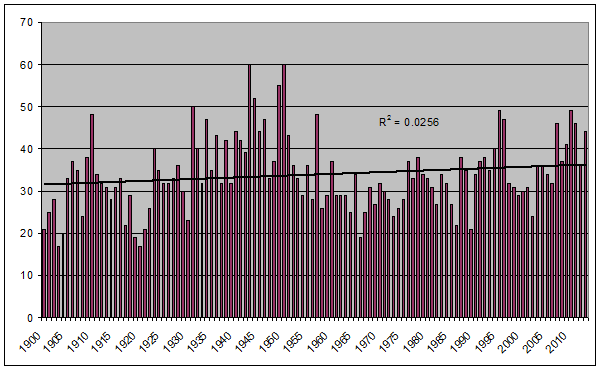
Do you have excel?
I seem to be unable to find the graph to which you are linking to, could you please link directly to where I could find it.
Here is the chart for 6.5+. However, the caveats about locating earthquakes before the great increase in the numbers of seismic stations should be heeded.
In any case, an R squared value of 0.025 does not really indicate a trend of statistical significance. Move the starting year forward a few years and the trend slope declines.

edit on 4/15/2014 by Phage because: (no reason given)
reply to post by Phage
No excel on the computer I am currently using, toss me a link to the data and I can run it tomorrow afternoon.
I agree it is not very significant given the entire period of recorded data, but relative to the normal person's lifespan there has been increasing quake activity. Remember my response was to this:
So deviation from the entire period of historic data shows little deviation, but recently (60's) quake activity has increased over the average living person's life.
We could do this very same thing in regards to climate.
-FBB
/EDIT
Not sure exactly how excel calculates standard deviation, it would be great if they included an excel sheet of the actual data to manually code the standard deviation.
No excel on the computer I am currently using, toss me a link to the data and I can run it tomorrow afternoon.
I agree it is not very significant given the entire period of recorded data, but relative to the normal person's lifespan there has been increasing quake activity. Remember my response was to this:
Just more people reporting it because of more people online and better infrastructure and tech to monitor them
Nothing is out of the orderly or changed only our communicative abilities and tech
So deviation from the entire period of historic data shows little deviation, but recently (60's) quake activity has increased over the average living person's life.
We could do this very same thing in regards to climate.
-FBB
/EDIT
Not sure exactly how excel calculates standard deviation, it would be great if they included an excel sheet of the actual data to manually code the standard deviation.
edit on 14-4-2014 by FriedBabelBroccoli because: 101
reply to post by FriedBabelBroccoli
The Centennial Earthquake Catalog 1900-2007:
earthquake.usgs.gov...
For period subsequent:
earthquake.usgs.gov...
That would depend on what magnitude range and period you select. The trouble with that is you can risk getting into cherry picking. Here is the data for 5.5+. Pretty flat.
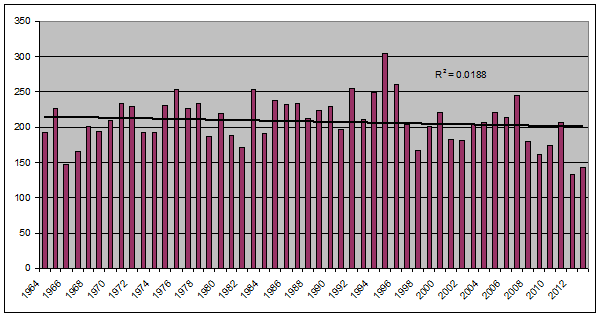
The Centennial Earthquake Catalog 1900-2007:
earthquake.usgs.gov...
For period subsequent:
earthquake.usgs.gov...
Not really.
So deviation from the entire period of historic data shows little deviation, but recently (60's) quake activity has increased over the average living person's life.
That would depend on what magnitude range and period you select. The trouble with that is you can risk getting into cherry picking. Here is the data for 5.5+. Pretty flat.

Standard deviation is a standard formula but the trendline is a linear regression (also standard).
Not sure exactly how excel calculates standard deviation, it would be great if they included an excel sheet of the actual data to manually code the standard deviation.
edit on 4/15/2014 by Phage because: (no reason given)
reply to post by Phage
No professors (sciences/engineering) at my Uni will accept regressions or stand devs from excel, they may have fixed things but we all use Apache anyways. That n-1 . . .
Either way I can rip the stats and will check it out tomorrow, thanks for the clarification.
-FBB
No professors (sciences/engineering) at my Uni will accept regressions or stand devs from excel, they may have fixed things but we all use Apache anyways. That n-1 . . .
Either way I can rip the stats and will check it out tomorrow, thanks for the clarification.
-FBB
reply to post by FriedBabelBroccoli
Of course not. "Show your work."
No professors (sciences/engineering) at my Uni will accept regressions or stand devs from excel, they may have fixed things but we all use Apache anyways.
Of course not. "Show your work."
reply to post by Mianeye
Ok.. So you're saying that all the weight of the north pole dispersing from the tectonic plates won't make a difference? Use your brain..
Ok.. So you're saying that all the weight of the north pole dispersing from the tectonic plates won't make a difference? Use your brain..
PlanetXisHERE
br0ker
reply to post by Conspiracyskeptic
Ice caps are melting fast! Trillions upon trillions of tonnes of weight is shifting. The plates are bound to move. You will see earthquakes more frequent and bigger. You will also see vulcanoes going off, climate change with more superweather.. Etc etc
This has no basis in science, think about it. We have only heard about much melting of ice in the Arctic, and what is Arctic ice on top of? Water. There has been some melting on Greenland but not enough to affect tectonic plates, and there has been little melting in the Antarctic where the largest ice cap in the world is.
The have been many more large earthquakes over the past decade or so starting with the Indonesian one in 2004, but the are not due to melting ice.
Does the rise in earthquakes have anything to do with the rise in other phenomenon like the rise in fireballs, sinkholes, strange trumpet noises..........
No, the north pole ice rests on land. And huge deposits of metane that will drive global warming exponentially.
Read up!
reply to post by br0ker
It's called the Arctic Ocean for a reason. The northern ice pack sits almost entirely on water..
It's called the Arctic Ocean for a reason. The northern ice pack sits almost entirely on water..
The North Pole is significantly warmer than the South Pole because it lies at sea level in the middle of the Arctic Ocean (albeit mostly frozen), where as the South Pole is significantly elevated on the frozen continent of Antarctic.
Phage
reply to post by FriedBabelBroccoli
No professors (sciences/engineering) at my Uni will accept regressions or stand devs from excel, they may have fixed things but we all use Apache anyways.
Of course not. "Show your work."
Okay I got slightly higher values, subtracting the summations of each series as opposed to doing it within the series lowered the values. However, the difference is certainly not enough to support any fear mongering.
Playing with the average life spans (Americans - Midpoint):
Gen Y has experienced an increasing frequency above the average
Gen X is slightly down
Millennials are up more so than the Y's
I might play with some of the demographics later for some fun comparisons, but was so kindly assigned the responsibility of coding a simulation of charge flow in R^3 in C (wtf team . . . ) for a series of alloys. So it may take a while to get around to.
Why does this crap always get dropped on you when you finally find something interesting enough to actually play with it.
-FBB
a reply to: Rezlooper
Interesting. Sure methane levels may be rising, but I can't see any possible connection between rising methane and many of the new and/or increasing events.
How could rising methane levels possibly effect the tectonic plates and cause them to be more active? Some melting ice in Siberia? In order to effect the tectonic plates we would have to see a significant amount of water released - enough to cause a several foot change in ocean levels, and while the oceans may have risen a few inches a few feet obviously hasn't happened.
Plus melting ice is gradual. There is more evidence that the tectonic plates are affected by sudden openings of coronal holes on the sun. See this thread: www.abovetopsecret.com...
Meteors will burn up in the atmosphere with or without methane, the chemical combustion may be slightly different with increased levels of methane, but not noticeable to the human eye, but either way they will be seen, so no, we are getting more meteors and not just seeing the same amount meteors become more visible due to increasing methane, there are more fireballs.
Sinkholes (non-karst underlain type) are increasing in areas with rift-faults - this is the obvious conclusion though no one is talking about it, to think this has anything to do with methane is ridiculous.
Strange noises heard around the world, again the obvious answer is increasing tectonic activity, though again no one in the MSM or government is talking about it, nothing to do with methane.
I think you need to spend your time on another theory, methane levels may be rising, that may be dangerous locally and globally, but it certainly doesn't explain many of the once rare phenomenon that are occurring with increasing frequency.
Interesting. Sure methane levels may be rising, but I can't see any possible connection between rising methane and many of the new and/or increasing events.
How could rising methane levels possibly effect the tectonic plates and cause them to be more active? Some melting ice in Siberia? In order to effect the tectonic plates we would have to see a significant amount of water released - enough to cause a several foot change in ocean levels, and while the oceans may have risen a few inches a few feet obviously hasn't happened.
Plus melting ice is gradual. There is more evidence that the tectonic plates are affected by sudden openings of coronal holes on the sun. See this thread: www.abovetopsecret.com...
Meteors will burn up in the atmosphere with or without methane, the chemical combustion may be slightly different with increased levels of methane, but not noticeable to the human eye, but either way they will be seen, so no, we are getting more meteors and not just seeing the same amount meteors become more visible due to increasing methane, there are more fireballs.
Sinkholes (non-karst underlain type) are increasing in areas with rift-faults - this is the obvious conclusion though no one is talking about it, to think this has anything to do with methane is ridiculous.
Strange noises heard around the world, again the obvious answer is increasing tectonic activity, though again no one in the MSM or government is talking about it, nothing to do with methane.
I think you need to spend your time on another theory, methane levels may be rising, that may be dangerous locally and globally, but it certainly doesn't explain many of the once rare phenomenon that are occurring with increasing frequency.
edit on 19-4-2014 by PlanetXisHERE because: grammar, syntax and context
Presented without comment:
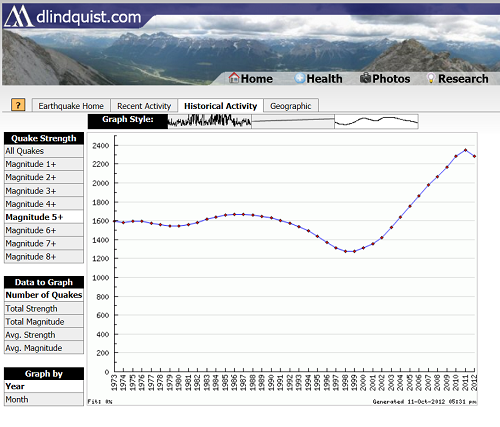
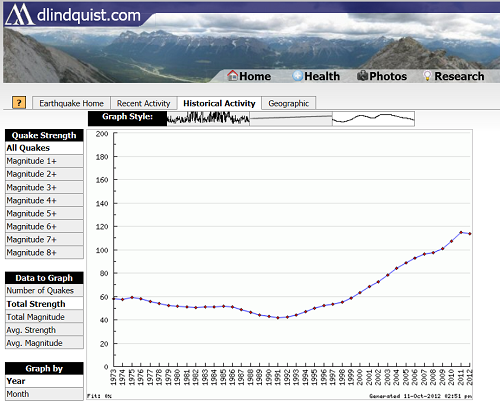
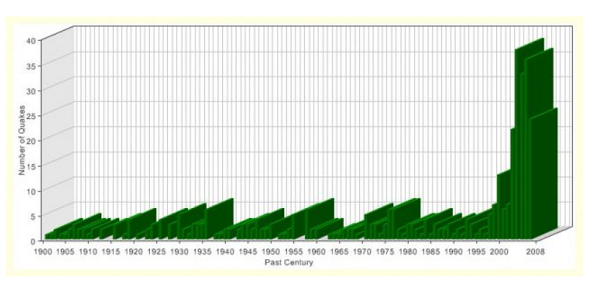





edit on 19-4-2014 by PlanetXisHERE because: correction
Can I ask a dumb question? Is there any relation to earthquakes and the distance of the Earth to the Sun? What I mean is like how things contract and
expand with cold and heat.
a reply to: Conspiracyskeptic
It has to do with the Earth Mantle, the Mantle's convection current or flow under the crust is causing worldwide hot spots making even long dormant volcanos to liven up again
there's a lot of heat coming up from the Earth Core area to the crustal plate
and that mantle movement (hotter convection currents, some million years in duration) going on a couple miles down & below the crustal plate which in turn triggers outgassing in the ocean plates and continental plates and shifts in the crust strata that result in plate movement/earthquakes
it is a cycle, see; mankelwitz or something like that name...
a lot of interlocking cycles
here you go: ossfoundation.us...
Milankovitch
It has to do with the Earth Mantle, the Mantle's convection current or flow under the crust is causing worldwide hot spots making even long dormant volcanos to liven up again
there's a lot of heat coming up from the Earth Core area to the crustal plate
and that mantle movement (hotter convection currents, some million years in duration) going on a couple miles down & below the crustal plate which in turn triggers outgassing in the ocean plates and continental plates and shifts in the crust strata that result in plate movement/earthquakes
it is a cycle, see; mankelwitz or something like that name...
a lot of interlocking cycles
here you go: ossfoundation.us...
Milankovitch
edit on th30139792060919162014 by St Udio because: add info & 50 cent words
edit on th30139792075019192014 by St Udio
because: add the term cycles as being important
originally posted by: PlanetXisHERE
a reply to: Rezlooper
Interesting. Sure methane levels may be rising, but I can't see any possible connection between rising methane and many of the new and/or increasing events.
How could rising methane levels possibly effect the tectonic plates and cause them to be more active? Some melting ice in Siberia? In order to effect the tectonic plates we would have to see a significant amount of water released - enough to cause a several foot change in ocean levels, and while the oceans may have risen a few inches a few feet obviously hasn't happened.
Plus melting ice is gradual. There is more evidence that the tectonic plates are affected by sudden openings of coronal holes on the sun. See this thread: www.abovetopsecret.com...
Meteors will burn up in the atmosphere with or without methane, the chemical combustion may be slightly different with increased levels of methane, but not noticeable to the human eye, but either way they will be seen, so no, we are getting more meteors and not just seeing the same amount meteors become more visible due to increasing methane, there are more fireballs.
Sinkholes (non-karst underlain type) are increasing in areas with rift-faults - this is the obvious conclusion though no one is talking about it, to think this has anything to do with methane is ridiculous.
Strange noises heard around the world, again the obvious answer is increasing tectonic activity, though again no one in the MSM or government is talking about it, nothing to do with methane.
I think you need to spend your time on another theory, methane levels may be rising, that may be dangerous locally and globally, but it certainly doesn't explain many of the once rare phenomenon that are occurring with increasing frequency.
It has everything to do with global warming, sped up by the escalating methane levels. You have to know that the continental shelf is thin and it doesn't take too much weight transfer to cause some reaction. Movement in one area will cause chain reactions, thus, rifting in the crust far away from fault lines. Why is it that one large earthquake after another is occurring right now? It's a chain reaction.
Going back to 1990 there were NO years where we had 4000+ quakes in the States...until 2009, when we had 4264. I thought about posting this last year, but since the new 'top' in 2009 wasn't THAT much higher than the previous one, I decided to wait for better confirmation, so as not to be alarmist. I was still hoping I was wrong at that point. This year we are rapidly closing in on 8000 quakes, though I doubt we will get there before Jan 1. That is truly a frightening spike. I predicted it, I was expecting an increase, but...wow, not like that. It's unquestionably time to be alarmed now.
Source
Jonny Mnemonic of Jumping Jack Flash Hypothesis posted this theory about earthquakes from methane and hydrogen sulfide in 2010 and he said that volcanoes and earthquakes would continue to increase...I believe he was right. I wonder how many earthquakes (all of them) have occurred so far in the United States, I haven't looked it up, but I'm sure it's quite a bit since Oklahoma alone has had over 1,000 quakes in the first three months.
Here's more from the theory;
Basically, I proposed a simple concept: that a gram of water in a dam's reservoir weighs the same as a gram of water off the coast of Japan (or California, or Indonesia, whatever), and if weight in a dam's reservoir can cause earthquakes (and clearly they can and sometimes do), then introducing extra mass to new areas globally would increase seismic instability globally.
Where is all the extra mass coming from? Well, most of it, obviously, from melted ice, quadrillions of tons. The entire planet looks different from orbit now compared to what it once looked like. Now, I'm not saying some extra water mass can make a completely geologically inactive area do anything. But a LOT of volcanoes and tectonics just need a little extra pressure to blow. Also, most of the ice is melting away from thick continental plates and is ending up in the oceans, where the plates are much thinner and therefore more sensitive.
The oceans are the planet's reservoir. The vast amounts of ice that are melting off the land are filling up that reservoir. Essentially, MISA Theory is very similar to the concept behind Reservoir-Induced Seismicity, but on a global scale and with three differences: 1) nobody did a geological survey of the reservoir area to make sure that the added mass wouldn't cause problems, as is always done with dams; 2) the plates under the oceans are far more fragile than those beneath any land-based reservoir; and 3) this reservoir cannot be drained to relieve pressure.
POSTULATE ONE: The global mass redistribution that is occurring is the proximate (direct) cause of the increase in seismic activity being experienced across the world.
Here's a factoid: each square mile of water that is one meter deep weighs 5,709,917,475 pounds. Not quite 6 billion pounds. Now you're thinking, well, we don't have one meter of sea level rise yet. That's true. But realize, sea level rise is not the same from area to area. Some areas have higher amounts than the average, some lower. It's possible that we're creeping up on that amount in some areas already. In any case, the process is ongoing, the mass flowing in continuously, month after month, year after year.
Think about your average volcano sticking out of the ocean. It may have 100 square miles (10x10 miles) where added mass could have some effect. So if the sea level around that volcano is increased by one meter then the amount of newly-introduced weight affecting that volcano is 570 billion pounds. If it was 99% of the way to blowing its top already then that might just be plenty to push it over the edge. The same is true of faults, except their area is often much larger.
POSTULATE TWO: All faults and volcanoes have tipping points. The more mass that is added to the oceans, the more of those tipping points we will reach, and the more seismic activity we will experience, particularly in the oceans and near coastal areas. This is happening now.
These were predictions Jonny made in 2010. What's increased since? Earthquakes, volcanoes, sinkholes, landslides, land cracks, loud booms and sky noise. All the result of earth crustal movement because of massive changes in weight either increasing or decreasing in different parts of the world....because of so much land ice melting...because of warming temperatures...because of escalating methane levels creating a blanket over our planet that trap's the sun's heat. Don't just tell me I'm wrong without anything to back it up. Prove I'm wrong and then I'll go come up with some other theory, but for now, I believe I'm dead right! And we all better start thinking up a back up plan for our survival.
a reply to: Rezlooper
Not volcanoes. Not earthquakes. Pretty hard to track those other things though. Aftershocks from the Tohoku quake created a nice spike in 2011 though.

www.volcano.si.edu...
earthquake.usgs.gov...
These were predictions Jonny made in 2010. What's increased since? Earthquakes, volcanoes, sinkholes, landslides, land cracks, loud booms and sky noise.
Not volcanoes. Not earthquakes. Pretty hard to track those other things though. Aftershocks from the Tohoku quake created a nice spike in 2011 though.

www.volcano.si.edu...
earthquake.usgs.gov...
edit on 4/19/2014 by Phage because: (no reason given)
a reply to: Phage
It's funny. For the last year and a half, I've been under the impression we average 60 volcanoes a year while 2013 turned up 83 eruptions. Your source claims the exact opposite, 80 volcanoes a year with down to about 60 last year. LOL, I don't know about that one. Somebody sure is trying hard to pull the wool over our eyes, huh. Surely, that wouldn't be you Phage. Your graph shows 63 volcanoes last year while there were actually 83.
It's funny. For the last year and a half, I've been under the impression we average 60 volcanoes a year while 2013 turned up 83 eruptions. Your source claims the exact opposite, 80 volcanoes a year with down to about 60 last year. LOL, I don't know about that one. Somebody sure is trying hard to pull the wool over our eyes, huh. Surely, that wouldn't be you Phage. Your graph shows 63 volcanoes last year while there were actually 83.
Seismologists have looked at the current rate of earthquakes many ways, and the most careful studies find at best an insignificant increase in the
number of great earthquakes, probably just a random fluctuation, and no increase in large earthquakes.
most relevant work I know:
Michael, A. J., 2011, Random variability explains apparent global clustering of large earthquakes, Geophys. Res. Lett., 38, L21301, doi:10.1029/2011GL049443.
Shearer, P. M., and P. B. Stark, Global risk of big earthquakes has not recently increased, Proc. Nat. Acad. Sci., 109, 717-721, www.pnas.org/cgi/doi/10.1073/pnas.1118525109, 2012.
a reply to: Phage
most relevant work I know:
Michael, A. J., 2011, Random variability explains apparent global clustering of large earthquakes, Geophys. Res. Lett., 38, L21301, doi:10.1029/2011GL049443.
Shearer, P. M., and P. B. Stark, Global risk of big earthquakes has not recently increased, Proc. Nat. Acad. Sci., 109, 717-721, www.pnas.org/cgi/doi/10.1073/pnas.1118525109, 2012.
a reply to: Phage
a reply to: Phage
I follow Extinction Protocol which provides links to each news event as they happen and they number each volcano eruption through the year. Not sure they can fudge that up when they provide links. They also use Volcano Discovery.
In regards to earthquakes, why is that after Jan. 1, 2009, USGS stopped tracking quakes under 4.5 outside the U.S.(unless felt or damage had occurred). They did it to make the stats page look like quakes weren't rising to the untrained eye. For quakes in the range of 4.0 to 5.0 here is what the years looked like
2001 - 7991
2002 - 8541
2003 - 8462
2004 - 10,888
2005 - 13,917
2006 - 12,838
2007 - 12,078
2008 - 12,291
(now they don't track under 4.5)
2009 - 6805
2010 - 10,164
2011 - 13,315 (nearly the highest year and that's without quakes under 4.5)
2012 - 9534
USGS Source page
Then, after 2012, they don't keep this page at all.
So, now you have to use their search catalog page rather than actually see the statistics.
For other sizes, 3.0 to 4.0
2008 - 11,735
2009 - 2905
2010 - 4341
For size, 2.0 to 2.9
2008 - 3860
2009 - 3014
2010 - 4626
Hard to deny that there is a significant increase in quakes when these numbers rise that much without the USGS even tracking them outside the United States.
Why? Because the numbers were going up and in an attempt to make them look like they aren't, they dropped tracking a significant portion of quakes so the line graph didn't rise too much. They then put it into the fine print underneath so that you don't notice.
I follow Extinction Protocol which provides links to each news event as they happen and they number each volcano eruption through the year. Not sure they can fudge that up when they provide links. They also use Volcano Discovery.
In regards to earthquakes, why is that after Jan. 1, 2009, USGS stopped tracking quakes under 4.5 outside the U.S.(unless felt or damage had occurred). They did it to make the stats page look like quakes weren't rising to the untrained eye. For quakes in the range of 4.0 to 5.0 here is what the years looked like
2001 - 7991
2002 - 8541
2003 - 8462
2004 - 10,888
2005 - 13,917
2006 - 12,838
2007 - 12,078
2008 - 12,291
(now they don't track under 4.5)
2009 - 6805
2010 - 10,164
2011 - 13,315 (nearly the highest year and that's without quakes under 4.5)
2012 - 9534
USGS Source page
Then, after 2012, they don't keep this page at all.
We're transitioning to a new system, so this webpage is being phased out and is no longer maintained as of 11/27/12. To generate statistics for past earthquakes, please use the
So, now you have to use their search catalog page rather than actually see the statistics.
For other sizes, 3.0 to 4.0
2008 - 11,735
2009 - 2905
2010 - 4341
For size, 2.0 to 2.9
2008 - 3860
2009 - 3014
2010 - 4626
Hard to deny that there is a significant increase in quakes when these numbers rise that much without the USGS even tracking them outside the United States.
Why? Because the numbers were going up and in an attempt to make them look like they aren't, they dropped tracking a significant portion of quakes so the line graph didn't rise too much. They then put it into the fine print underneath so that you don't notice.
Starting in January 2009, the USGS National Earthquake Information Center no longer locates earthquakes smaller than magnitude 4.5 outside the United States, unless we receive specific information that the earthquake was felt or caused damage.
edit on 19-4-2014 by Rezlooper
because: (no reason given)
a reply to: Rezlooper
Did you ever hear something about the way the USGS assigned magnitude to quakes as well? I heard it changed in the 1970's, so say a 8.5Mag EQ in the 1960's would show up as a 7.5 Mag EQ say in the 1980's or today.
For example, didn't California experience a minor 5.1 Mag quake a couple weeks ago that seemed to be way stronger? I realize the perceived strength varies with your distance from the epicenter and the depth of the quake, but I lived in Taiwan for a while and experienced quite a few 5-6 mags, I remember distinctly one 5.8Mag that where the epicenter was only a few dozen miles away from Taipei and only about 50km deep, relatively close in EQ terms, and there was just a bit of shaking in the tall building that I was in.
From the looks of that 5.1Mag EQ in California a couple weeks ago, I would have guessed it was at least a 5.9Mag or higher. A 5.1 is nothing unless you are at the epicenter and it is less than 10km deep.
Did you ever hear something about the way the USGS assigned magnitude to quakes as well? I heard it changed in the 1970's, so say a 8.5Mag EQ in the 1960's would show up as a 7.5 Mag EQ say in the 1980's or today.
For example, didn't California experience a minor 5.1 Mag quake a couple weeks ago that seemed to be way stronger? I realize the perceived strength varies with your distance from the epicenter and the depth of the quake, but I lived in Taiwan for a while and experienced quite a few 5-6 mags, I remember distinctly one 5.8Mag that where the epicenter was only a few dozen miles away from Taipei and only about 50km deep, relatively close in EQ terms, and there was just a bit of shaking in the tall building that I was in.
From the looks of that 5.1Mag EQ in California a couple weeks ago, I would have guessed it was at least a 5.9Mag or higher. A 5.1 is nothing unless you are at the epicenter and it is less than 10km deep.
edit on 19-4-2014 by PlanetXisHERE because: epiphany
